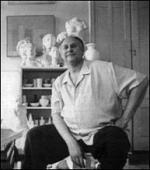
Vladimir Grigoryevich Weisberg
Vladimir Weisberg Heritage
The heritage of Vladimir Grigoryevich Weisberg (1924--1985) is large in both quantity and quality. This collection of painting is the result of two donations made in the late 1990s by the late artist’s relatives. The first donation included works from Weisberg’s later period -- fifty-seven works of painting and graphic art -- and was given to the Museum of Personal Collections by the artist’s widow Galina Yermina (1922--2003) in 1998. An additional thirty-two canvases from the artist’s early period (late 1940s--1950s) were presented by the painter’s first wife Svetlana Scheglova (1923--2001) in 2000. The resulting collection of almost ninety works chronicles the entire career of this remarkable Russian artist.
Vladimir Weisberg belonged to the “generation of the sixties” -- artists whose oeuvres developed independently of the official art of Socialist Realism. Unlike the majority of members of the Moscow avant-garde, however, Weisberg rejected political pathos. Although he exhibited alongside the artists of the “bleak style” and painted in a similar manner in the 1960s and 1970s, art historians tend now to rank him among such representatives of the metaphysical movement as Mikhail Shvartsman, Dmitry Krasnopevtsev, Vladimir Yankilevsky and Ulo Sooster.
Weisberg’s first studied painting under Sergei Ivashev-Musatov. After his teacher’s arrest in 1948, he continued to work with Ilya Mashkov and Alexander Osmerkin -- representatives of Moscow Cézanneism. [Bush] (1948) offers an insight into his early style of painting. Now on permanent exhibition, this study demonstrates the clear influence of Paul Cézanne.
The colour element continued to grow in Weisberg’s painting in the early 1950s, reaching its peak in a series of portraits painted in the second half of the decade. The artist’s models were typical inhabitants of post-war Moscow -- boys, girls and women. Weisberg sometimes approached the sitters directly on the streets. His portraits embrace a wide range of social classes, including such characters as [Lad with a Spanner, Holiday-Maker] and [Female Prison Warden]. [Galya in a Green Blouse] depicts a young girl with ginger hair and a bashful look in her smiling eyes. The green and ochre tones contribute to the sense of harmony. This work is one of the artist’s most spiritually lifting canvases.
[Family] (late 1950s) is a double portrait of the artist’s first wife Svetlana Scheglova and her father Victor Scheglov. This painting represents an important stage in the artist’s development. The dark silhouettes of the seated girl and the elderly man stand out against the light background. The poses and facial expressions of the two sitters are calm and dignified. Although the painterly interpretation of the clothes reflects the artist’s early manner of overcrossing coloured brushstrokes, new artistic principles can be seen in the faces and the white background.
The late 1950s and early 1960s were a crucial period in Weisberg’s career. He began to form his own concept of painting, which he continued to develop throughout the rest of his life. This concept was explained in a paper read and published by the artist in 1962 -- [Classification of the Main Forms of Colourist Perception]. Generalising and systematising the experience of the European masters of painting, Weisberg discerned three main forms of colourist perception -- short (momentary), long and continuous.
In the following years, Weisberg formulated the concept of “invisible painting” and his own individual union of the object and environment. The artist’s unique method of painting began with the application of a transparent, multi-coloured underpainting to the canvas. He then effected the “disintegration of colour” -- immersion in a single light environment vibrating with soft tones -- with the help of dottings. Geometric still-lifes were a typical form of compositional creativity during this period. Weisberg developed a complex system of colour disintegration, not employing white as such. Work on the canvas required numerous seances. [Chaos] (1974) is a typical example of such still-lifes. White geometric figures -- cones, cylinders, spheres and prisms -- are spread out over a plane (the upper edge of a white cube). The composition has a single light-carrying palette of similar tones. [Chaos] and two smaller works -- [Geometric Figures] (1973) and [Shell, Cube and Cylinder] (1974) -- constitute a triptych.
Weisberg continued to perfect his creative method over the years, experimenting with different types of prime coatings. The artist always primed his canvases himself and was very particular about the choice and quality of paints. The process of painting a picture was accompanied by a state of profound concentration. Geometrically regulated and painted in light-blue tones, [Architecture] (1975) is an example of Weisberg’s later, light compositions. The five white cylinders, perfect proportions and profusion of light evoke associations with Classical architecture.
Vladimir Weisberg did not succeed in finishing one of his last still-lifes -- [Venus and Geometry] (1994). This painting offers a fascinating insight into the artist’s process of work. The first stage was a light, almost watercolour underpainting, followed by gradual dottings, “extinguishing” the colour and immersing the objects in a monochrome, light-carrying environment. The disintegration of colour by light in this particular work was interrupted by the artist’s death, showing us the results of the artist’s first, direct perception of life -- something akin to a dark, multi-coloured fabric flowing with subtle tones.
Weisberg wrote: “Harmony is like an homogenous light gradually sensed through the construction. This light lies outside the bounds of our senses. When slowed down by our limited organs of sense, it is felt without being understood.”
Constructing still-lifes from plaster geometric figures combined with ancient casts or shells, the artist created a special world of peace, purity and equilibrium, based on a metaphysical understanding of light. Noting this persistent quest for ultimate harmony, Russian art historian Elena Murina called Vladimir Weisberg “a master whose art subordinates eternity.”





